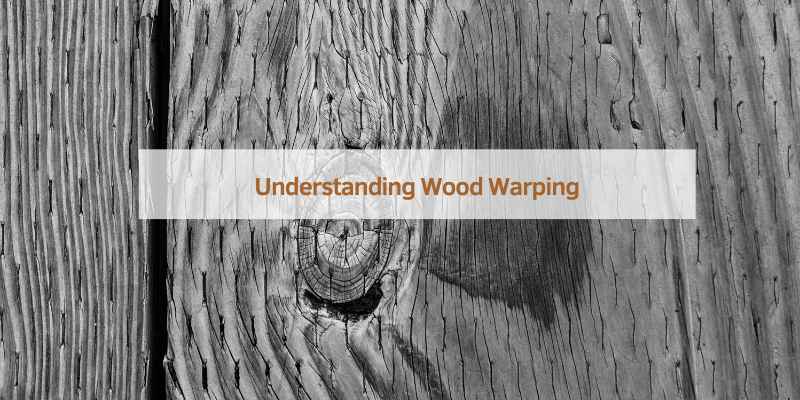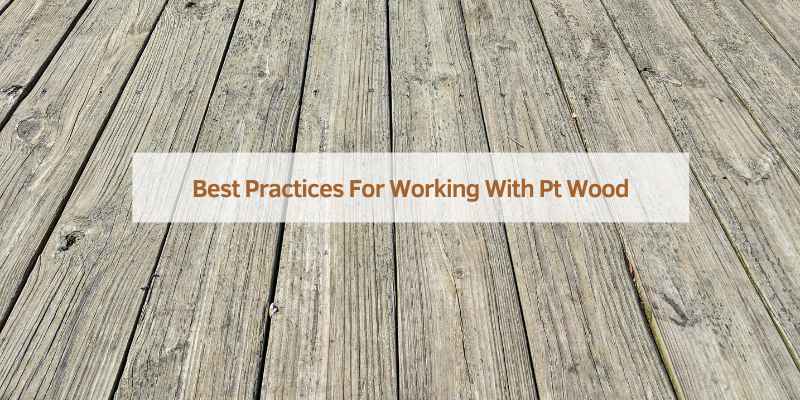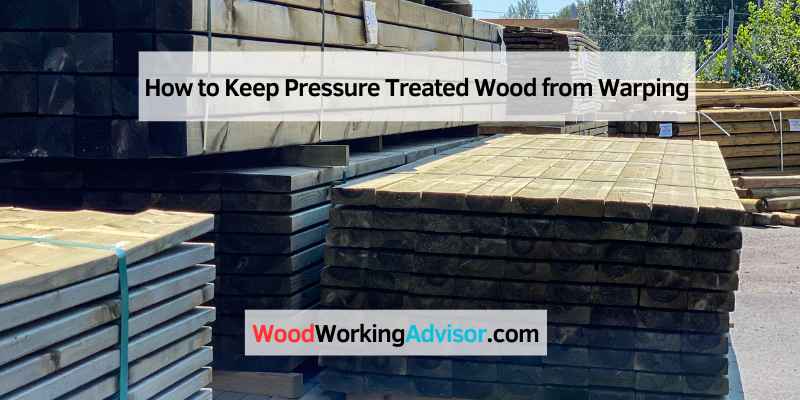To prevent pressure treated wood from warping, ensure proper storage techniques, including keeping all boards the same thickness, placing stickers flat and vertically aligned between boards, and resting the lumber on a flat foundation. Additionally, provide space between each board and stickers between layers to allow for drying and stabilization before use.
Pressure treated wood is known for its resistance to moisture, rot, and insects, making it a popular choice for decks and outdoor structures. However, this treatment process can often cause the wood to warp, which can lead to structural issues and a less attractive finished product.
By following proper storage techniques, such as uniform thickness, flat stickers, and allowing for drying before use, you can keep pressure treated wood from warping and ensure a sturdy and long-lasting outdoor structure.
Understanding Wood Warping
Pressure treated wood is known for its resistance to moisture, insects, and rot, making it a popular choice for outdoor projects like decks. However, pressure treated wood is also notorious for warping. To prevent warped wood, it’s important to store it properly and evenly, with flat stickers and a flat foundation.
Wood warping is a significant issue when working with wood, especially pressure-treated wood. Defined as any deviation from a true or plane surface, warping can affect any wood project’s stability, strength, and appearance. To keep pressure-treated wood from warping, you must first understand the causes and types of warping.
Causes Of Wood Warping
Several factors can cause wood to warp, but moisture is the primary culprit. The moisture content of wood varies depending on its species, environment, and time since it was felled. Additionally, uneven exposure to humidity, rainwater, and direct sunlight can cause wood to warp. The warping of pressure-treated wood can be caused by the pressure treatment process itself, which uses moisture and high pressure to force preservatives deep into the wood. The wood can absorb too much moisture, causing it to warp and twist.
Types Of Wood Warping
The four major types of wood warping are bowing, cupping, twisting, and crooking. Bowing is when the board bends along its length in a side-to-side fashion. Cupping occurs when the edges of the board curl up or down. Twisting involves the board rotating along its length. Finally, crooking takes place when the board twists and bends along its length. Understanding the type of warping that is occurring can help you determine how to correct and prevent it.
How Carpenters Work Around Wood Warp
Carpenters have several tricks up their sleeves to work around wood warp. The most important is proper storage and handling techniques. Keeping the wood flat, dry, and out of direct sunlight can prevent most warping. Additionally, using stabilizers such as cauls and stickers can help keep the wood flat during the drying process. Choosing quarter-sawn, rift-sawn, or plain-sawn boards, depending on your project’s design, can also help minimize wood movement. Finally, applying stains and finishes can help reduce the likelihood of warping, curling, and twisting. Ensuring proper care and maintenance at every stage of your project can help you keep pressure-treated wood from warping.

Proper Storage Techniques
To keep pressure treated wood from warping, proper storage techniques are crucial. Make sure all board and stickers are uniformly thick, with stickers lying flat and vertically aligned. Lumber piles should rest on a flat foundation to prevent any warping caused by uneven ground.
Pressure treated wood is widely used for decking, fencing, and exterior construction because of its resistance to rot, decay, and termites. However, it is notorious for warping due to its natural tendencies to absorb and release moisture. Proper storage techniques are critical to keep pressure treated wood from warping. In this section, we will cover some essential guidelines to help you store your pressure treated wood effectively.
Uniform Thickness For All Boards
One of the most essential factors to prevent warping is to ensure that all the boards in a stack are of uniform thickness, especially when placed on the same layer. This means that every board in the stack should have the same thickness. Uneven boards can lead to uneven drying and thus warping.
Stickers Placement And Alignment
Stickers are small pieces of wood that are placed between the boards in a stack to promote air circulation. The proper placement of stickers is essential to prevent warping. The stickers should be laid flat and vertically aligned. To ensure the alignment of the stickers, use a level for accuracy.
Flat Foundation For Lumber Piles
Another critical factor is the foundation you use for your lumber piles. Lumber piles should rest on a flat foundation, such as concrete or a level gravel bed. Avoid placing your lumber on an uneven surface, such as dirt or grass. This will result in uneven drying and warping of the wood.
In summary, pressure treated wood is prone to warping, but with proper storage techniques, you can easily prevent it. Always ensure that all boards are of uniform thickness, stickers are placed flat and vertically aligned, and lumber piles are resting on a flat foundation. Following these guidelines will ensure that your pressure treated wood remains straight and sturdy for years to come.
Preventing Wood Warping
Preventing wood warping can be a challenge, especially when it comes to pressure treated wood. However, proper storage techniques such as using uniform thickness boards and flat foundations can help keep treated boards from warping. Additionally, acclimating the lumber and using certain types of joinery can also help minimize wood movement.
Pressure treated wood is an excellent choice for outdoor building projects, but it is notorious for warping, which can be frustrating for the DIY enthusiast. Perhaps you have experienced this firsthand? Fortunately, there are several steps you can take to help keep your pressure treated wood straight and true. In this post, we will be discussing three practical approaches to preventing wood warping, including Let Wood Acclimate, Wrap Project Parts in Plastic, and Use Certain Types of Joinery.
Let Wood Acclimate
Allowing your pressure treated wood to acclimate to the environment in which it will be used is vital for preventing warping. This process allows the wood to adjust to the temperature and humidity conditions, reducing the risk of warping. When you receive your lumber, stack it flat, and let it sit for a couple of days before you start your woodworking project. This way, you will give time for the wood to settle and equalize in moisture content.
Wrap Project Parts in Plastic
Moisture is the primary factor that causes pressure treated wood to warp. Therefore, shielding your project parts from moisture is necessary to prevent warping. You can use plastic wrap to cover the wood parts and keep them safe from moisture. This will help prevent any warping before you start building your project.
Use Certain Types of Joinery
Using the right joinery can also help your pressure treated wood remain stable and straight. Consider using mortise and tenon, dovetail, or finger joinery, which are stronger and less likely to warp than other types of joinery. These types of joinery lock the wood parts together and strengthen the overall structure, thereby reducing the chance of warping.
In conclusion, by following the three practical approaches discussed above, you can significantly reduce the chance of your pressure treated wood warping. Allow ample time for the wood to acclimate, protect your project parts from moisture by wrapping them in plastic, and use joinery techniques that are strong and durable. By implementing these tips, you can enjoy your DIY project without worrying about warped wood.
Treating Pressure Treated Wood
Pressure treated wood is known to warp easily, but there are ways to prevent it. Proper storage techniques, such as keeping all boards and stickers of uniform thickness and vertically aligned, as well as allowing time for the wood to acclimate can help keep pressure treated wood from warping.
Additionally, straightening warped wood can be achieved with soaking in water or using Elmer’s white glue.
Straightening Warped Wood With Water Soak
If you’re dealing with warped pressure treated wood, don’t worry; there are several ways to straighten it out. One easy method is to soak the warped wood in water. Submerge the piece of wood in a shallow pool of water for at least 24 hours. The trapped water within the fibers makes the wood more flexible and allows for easy manipulation. After soaking, remove the wood from the water and attach weights to the end. This will help straighten the board as it dries.
Drying Pt Wood Without Warping
After treating pressure treated wood to prevent warping, it’s crucial to dry it gradually and evenly. Keep the wood in a shaded, cool, and windy location. Don’t let the wood sit in direct sunlight as it can heat up and cause warping. Also, avoid stacking the boards too tightly together. Allow for some air circulation to dry it naturally.
Another method to dry the pressure treated wood without warping is by using a dehumidifier. The dehumidifier removes excess moisture from the air and helps dry the wood at a steady rate.
Painting And Staining Pt Wood
Painting and staining PT wood can help prevent warping and prolong the life of your project. Before painting or staining, ensure the wood is dry and free of any oils, dirt, or debris. Sand the surface with a fine grit sandpaper to create a smooth surface. Make sure to apply the paint or the stain in thin, even coats. Avoid over-applying as it can lead to flaking or peeling.
In conclusion, treating pressure-treated wood requires patience, correct storage, proper drying, and careful maintenance to ensure that it remains free of warping. With these tips, you can keep your project looking great for years to come.
Best Practices For Working With Pt Wood
Pressure treated wood is known for its tendency to warp, which can be a headache for builders and DIY enthusiasts. To keep your pressure treated wood from warping, it’s important to properly store and acclimate it before use. You can also use certain types of joinery and staining methods to minimize wood movement and prevent warping.
Pressure treated (PT) wood is a popular material used for outdoor structures, decking, and fences. It is treated to resist moisture, rot, and insects, but it is also prone to warping. To prevent warping of PT wood, it’s essential to follow best practices that will ensure the longevity of your structures. In this blog post, we’re going to focus on best practices for working with PT wood, including choosing the right PT wood, proper installation techniques, and regular maintenance to ensure longevity.
Choosing the Right PT Wood
Choosing the right PT wood is crucial to preventing warping problems. It’s essential to select high-quality, well-dried, and straight boards. Be sure to avoid warped or twisted boards, as these will likely continue to warp after installation. Additionally, consider the type of wood you’re selecting. Softwoods such as pine and spruce are more likely to warp than hardwoods such as oak or cedar.
Proper Installation Techniques
Proper installation techniques are vital to the prevention of warping in PT wood. The first step is to ensure that the lumber is dried to the appropriate moisture content. Next, be sure to stack the lumber flat and use stickers between each layer to promote even drying. Also, use proper spacing between the boards to allow for airflow and drainage. When installing, be sure to use galvanized or stainless-steel screws, nails, or bolts that won’t corrode and compromise the integrity of the structure. Lastly, make sure all cuts are coated with an end-grain sealer to reduce moisture absorption.
Regular Maintenance to Ensure Longevity
Regular maintenance is crucial to the longevity of your PT wood structures. This includes regular cleaning to remove debris and maintaining sufficient airflow to prevent moisture buildup. Additionally, apply a high-quality water repellent or sealant to help maintain the integrity of the wood and reduce absorption of moisture. Finally, regularly inspect your structure for any signs of warping or damage and address any issues as soon as possible to prevent further damage.
In conclusion, choosing the right PT wood, using proper installation techniques, and regular maintenance are all essential factors that can help prevent warping in PT wood structures. By following these best practices, you can ensure the longevity of your outdoor structures, decking, and fences.

Frequently Asked Questions Of How To Keep Pressure Treated Wood From Warping
Is Pressure Treated Wood Prone To Warping?
Yes, pressure treated wood is prone to warping. Despite being treated to resist moisture, rot, and insects, pressure treated decking can be notorious for warping, which is one of the most significant issues with this type of decking. Proper storage techniques, such as uniform thickness and flat foundation, can help prevent warped wood.
Soaking in water or applying wet cloth on the inside of curved sections can also help straighten warped pressure treated wood.
How Do You Keep Treated Boards From Warping?
To prevent treated boards from warping, ensure they are stored properly. All boards and stickers in a stack should be of uniform thickness, stickers should be vertically aligned and stacked on a flat foundation. Give the wood a few days to dry and stabilize with space between each board before using.
Soaking the wood in water can also straighten warped boards.
How Do You Straighten Warped Pressure Treated Wood?
To straighten warped pressure treated wood, soak it in water or apply a wet cloth to the inside of the warped curve until it straightens. Afterward, switch the water formula for an Elmer’s white glue or a wood glue with water.
Proper storage techniques can also prevent warped wood.
How Do You Dry Pressure Treated Wood Without Warping?
Proper storage techniques are essential to prevent warping of pressure-treated wood. All boards and stickers placed between them should be of uniform thickness and vertically aligned in a flat-laying foundation. Soaking in water or placing a wet cloth on the inside of the warp curve can straighten warped wood.
Give the wood space between each board and stickers between layers to dry and stabilize to avoid warping.
Conclusion
Keeping pressure treated wood from warping requires proper storage, handling, and maintenance techniques. By following the guidelines we’ve discussed, such as using stickers for uniform spacing between boards and allowing the wood to acclimate to its surroundings, you can prevent warping and ensure your wood lasts for years to come.
With the right approach, you can enjoy the benefits of pressure treated wood without worrying about warping.


